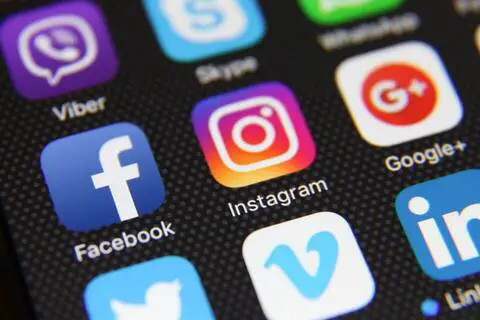Tips to Get Started on Social Media
6 MIN READ

It's not exactly news that social media sites such as Facebook, Twitter, and Instagram are hugely influential right now. At the same time, many small businesses aren't sure how to get started with social media accounts that will actually help them get more customers. Even if you spend hours every day on Facebook, that's not the same thing as using the site to build your business. Your customers probably won't be too interested in seeing photos of your cat or what you had for lunch. You need a specific strategy for business marketing. In this article, we'll be looking at some simple and effective guidelines for getting off the ground with social media.
Why Social Media?
Before we get into specifics about getting started on social media, it's worth it to briefly summarize why you should make this a priority. Consider the following statistics, which were recently shared by Small Business Trends:
- More than 77% of businesses now use social media to promote themselves. Odds are that your competitors are using social media. If you aren't, you risk falling behind. For example, if you have an Italian restaurant in Orlando, Florida, many potential customers will look up listings and reviews on Facebook. If you aren't there, you'll lose potential business. The same is true if you're an accountant, dentist, hairdresser, lawyer, or DJ.
- 90% of marketers who use social media report that their efforts have increased exposure for their businesses. This is important because it goes beyond simply making sales (which you want, of course). Part of the reason to use social media is to build your brand. Put more simply, you want people to hear about you so they're familiar with your name. One reason large brands spend so much money on ads is to make sure you never forget about them.
- More than 1 in 3 internet users (which means the vast majority of your potential customers) look to social media when seeking information about a business or product. This may not impress you if you calculate that 2 out of 3 don't consult social media. However, since we're talking about such large numbers of people, a third is still many people. If there are 100,000 people in your city, and 33,000 are looking for something you sell, wouldn't you want to reach out to them? Furthermore, even the ones who aren't specifically looking for you may become customers if they find your pages.
Which Social Media Sites?
Social media covers lots of different sites. You have limited time and resources so it doesn't make sense to start an account on every single social media platform. If you do this, you'll be spreading yourself too thin. Instead, focus on where your customers (or potential customers) are most likely to find you. Here's a summary of some of the most popular sites and how they can be used for small business marketing.
This is the big one, with over 2 billion users. There's really no need to overthink this. No matter what you're selling, you need to be on Facebook. At the very least, this means having a Facebook Page and posting regularly to your timeline. You might also look into innovative features such as Facebook Live, which lets you talk to your followers in real time. Stories is another powerful feature where you can post content that stays up for 24 hours. People see Stories at the top of the page, so they really stand out.
Twitter, while not quite as popular as Facebook, fills a unique function. There's a definite benefit to sharing short snippets to your followers which can include the latest news, products, links, or photos. Remember that you can send people from Twitter to anywhere else such as your business website, a video, blog post, or Facebook page. To make the most of Twitter marketing, you need to post frequently and figure out the optimal times for your tweets.
Though owned by Facebook, Instagram has its own distinct audience. Overall, Instagram users tend to be younger than Facebook or Twitter users. Of course, images rule on this site. If you sell anything that can be visually represented, including food, jewelry, fashion, travel destinations, or real estate, this is a site worth cultivating. Many large brands leverage Instagram by posting compelling photos. For example, Lego has 4 million followers who keep up with the company's creative toys.
Like Instagram, Pinterest is primarily a visual site. There are several important facts to know about this site. For one, it's probably bigger than you realize with some 265 million users, as reported by Social Media Today. Another crucial thing to know about Pinterest is that its users are buyers, with 93% of pinners using the site to make purchases (or research for future buying). Pinterest has traditionally been used mainly by women but this is changing now with more men joining.
If you want to see an example of a company making the most of Pinterest, check out Ikea, with over 10 million monthly viewers. Note that in addition to featuring their own products they also share information useful to their customers, such as organizing tips by Marie Kondo.
With over 450 million members, LinkedIn is another very large social media site. What's different about LinkedIn is that it's designed as a B2B (business-to-business) platform. In short, if your customers are other business owners (or decision-makers for businesses such as managers), you need to be on LinkedIn. Otherwise, it's probably not worth your effort. This site is also great for finding employees, connecting with potential investors, and keeping track of trends in various industries.
LinkedIn has a timeline style similar to Facebook's. In addition to sharing information, you can also build your credibility by publishing long-form articles on LinkedIn Pulse. This content not only builds your authority but can get you traffic from Google as well as LinkedIn itself. Tom Popomaronis shares some helpful tips he learned after publishing 50 articles on LinkedIn.
Snapchat
Snapchat is not quite as big as its competitors but still has around 187 active daily users, as reported by Brandwatch. Snapchat is mainly popular with young people, with 60% of its users under 25. If you have a young and hip audience, this platform is worth considering. Snapchat was the first social media site to introduce the Stories feature, lately copied by Instagram and Facebook. Neil Patel shares some useful advice for Snapchat marketing.
Social Media Guidelines to Keep in Mind
Here are some things to remember no matter which social media platforms you're using.
- Set goals. You may be trying to capture leads for your email list, get more sales, or build interest for your brand or a particular product, service, or event.
- Build relationships. It's called social media for a reason. Post content with the intention of communicating with your audience. Ask questions. Answer comments. Show people that you appreciate their interest.
- Inform and entertain. If you only use social media to brag and toot your own horn, your followers will get bored. Be sure to share content that's interesting. Share compelling images and videos, industry news, helpful tips, and anything your customers would like to know.
- Share strong visual content. Photos, videos, infographics, and memes are more likely to be noticed and shared than text alone. Video marketing on social media can be especially effective.
- Track your results. Whether you use your own analytics tools or work with an agency, make sure you keep track of metrics. You want to know, for example, which of your posts are most read, which are shared the most, and which lead to conversions. To start off, you can check analytics pages offered by the social media sites themselves such as Facebook Analytics and Twitter Analytics.
- Experiment with advertising. If it's within your budget, consider testing ads on Facebook, Instagram or other sites. With paid campaigns, it's exceptionally important to track your ROI. Start small and scale up as you find out what works.
Social media can seem overwhelming as new trends quickly come and go. However, if you focus on the platforms that your customers prefer, provide compelling content, and communicate consistently with your audience you'll find that your influence will grow. If you need help getting started with social media, one option is to outsource some of these tasks to an experienced agency such as MarComm.
Recent Posts

Should You Jump Into Social Media Marketing?
Social media is all the rage these days—but that's no reason to invest in...

Is Outsourcing Social Media Right for Your Business?
Social media is all the rage these days—but that's no reason to invest in...

Why Video is the Top Trend for Social Media Marketing in 2019
Social media marketing is a field that's constantly evolving. New platforms,...
